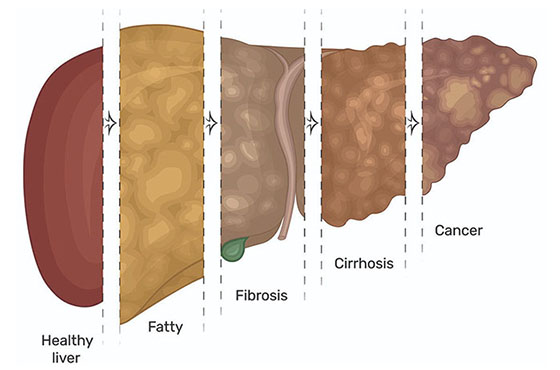
A Story of Failure
We often talk of success stories. Let’s talk about a story where we failed. Dr. Chandra was an elderly gentleman settled in Dubai since past 40 years. He was a medical doctor and used to work at a Dubai Government Medical Clinic. He was a long-standing diabetic and slightly overweight. He used to manage his health quite well with regular checks and proper medications. He was physically active and used to exercise daily. He had a happy family with two daughters and a son who were born and brought up in Dubai and now married and well settled. Dr. Chandra was aware he had fatty liver, and this was no surprise since most diabetics and overweight individuals do have fatty liver. His liver tests were normal, he did not consume alcohol and he had never had any symptoms of liver disease. He was reassured that he had simple fatty liver which was not of much consequence. He was not regular with ultrasound scans, but he did use to get a scan once every two to three years. He presented to me a little over a year ago with upper abdominal pain, swelling of the abdomen and legs. Upon further investigations, it was found that he had liver cirrhosis and had developed quite an advanced liver cancer. We took opinion from experts on oncology, liver surgery and liver transplantation but unfortunately, we could only offer him palliative chemotherapy with which he survived about a year. Thankfully his wife, children and grand children were with him during his last weeks of life.
Dr. Chandra was a well-known doctor and must have helped thousands of patients get well. But he himself died of liver cancer despite maintaining himself in good health. Let’s try to explore why this cancer happened and how it could have prevented or detected early at a stage when it could be treated.
Primary liver cancer is not a very common cancer, accounting for about 2% of all cancers. What is important is to understand that there are certain individuals who are at high risk for developing primary liver cancer. The most important risk factor is presence of liver cirrhosis. Liver cirrhosis is essentially scarring of the liver, that happens due to excessive alcohol use, hepatitis B or C infection and more commonly due to metabolic fatty liver disease that is common in individuals who are overweight or diabetic. Up to 5 percent of individuals with liver cirrhosis develop liver cancer. Most people with early-stage liver cirrhosis do not have any symptoms and may not be aware that they have cirrhosis. These includes a lot of people with incidentally detected fatty liver disease. About a third of all individuals with fatty liver have ongoing liver inflammation that can progress to advanced liver fibrosis and cirrhosis and these patients then have an increased risk of liver cancer. Apart from liver cirrhosis, diabetes and obesity are independent risk factors for development of liver cancer.
The most important thing for patients with any form of liver disease, be it simple fatty liver, is to know whether they have advanced liver fibrosis or cirrhosis and to understand whether they are at high risk for progression of liver disease. Routine blood tests and ultrasound scans do not detect liver fibrosis and early cirrhosis. To detect liver fibrosis one needs to assess liver stiffness. Livers which are firm, stiff or hard have more fibrosis or cirrhosis compared to soft livers which are healthier. Liver stiffness can be easily and non-invasively assessed by a technique called liver elastography. Liver elastography can be done either by using an ultrasound-based technique called Fibroscan or by a specialized MRI-based technique called MR Elastography. Patients with any form of liver disease including fatty liver must do elastography once every 2-3 years to assess the exact status of liver fibrosis. This equally applies to those who drink excessive alcohol, diabetics, and obese individuals, most of whom have underlying fatty liver disease. One must also screen for presence of hepatitis B and C infection at least once in a lifetime since these are an important cause of liver cirrhosis and liver cancer and essentially treatable conditions.
Early detection of liver cancer requires periodic liver scans (ultrasound scan every 6 months and an annual MRI scan of the liver in selected cases) and blood tests. Liver cancer that is detected early when it is small (less than 2-3 cm in size) has a good chance of cure with modern treatment modalities. But for screening to happen, one must be aware whether there is advanced liver fibrosis or cirrhosis. Hence the importance of liver elastography. Remember, liver disease is silent and fatty liver is often not regarded as a major problem. If you are diagnosed to have fatty liver, ask your doctor whether you have liver fibrosis or not. Do not get reassured with a normal liver function test and ultrasound scan result. Do a liver elastography (Fibroscan) to make sure that your liver is soft and healthy. I wish Dr. Chandra would have had a liver elastography few years ago so that we would have known that he had liver cirrhosis and he would have had regular screening for early detection of liver cancer.

 Book Online Consultation
Book Online Consultation